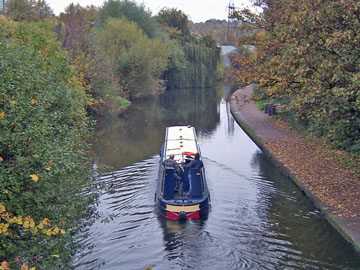News
What kind of future for our local waterways heritage?

'The private sector built the canals, the public sector rescued them and I believe the third sector are their future'. Tony Hales, Chairman, British Waterways.
British Waterways, which currently manages some 2,200 miles of canals and rivers in England and Wales, has launched a little publicised public consultation exercise which should be of interest to local historians. Despite a high profile launch on 18 May 2009 at the House of Commons, their proposal that our canals and rivers should, over time, be moved out of direct state control and into a new ‘national trust’ for waterways has received little attention in the national media.
Today, waterways play an important role in supporting jobs, waterside regeneration, biodiversity and the leisure and tourism industry, but the mounting cost of maintaining an ageing canal network ― with many listed structures ― has led British Waterways to explore alternative ideas for securing the waterways’ future. By becoming a trust, British Waterways believes that it would be able to encourage greater community ownership of local waterways, more involvement from the voluntary sector and create a wider funding base.
British Waterways' maintenance programme has an annual shortfall of £30million, for which there needs to be a long-term solution ― hence the consultation exercise and the publication of TwentyTwenty: A vision for the future of our canals and rivers, together with a YouTube film and supporting website. The vision has three 'sustainability' strands (environmental, social and economic), each containing a number of elements, including a proposal that BW should do more to 'champion the built canal environment, however big or small'. They also want to see 'active participation by canal supporters and stakeholders in the management of BW, which will lead to a greater sense of shared responsibility'. The economic strand is also being acted upon, with a plan to create new operational regions for day-to-day management, whilst creating national units to manage specialist services ― details of which have been published in a separate consultation. If approved, this will see the creation of eleven new maintenance regions and national units to manage other activities. However, the downside of the changes will be the loss of up to one hundred jobs, whilst the upside will be £10million extra for maintenance every year. More information about the proposal can be found on the British Waterways' website.

An inner-city section of the short, but important, Nottingham and Beeston Canal, which is probably typical of the kind of city canal which we take for granted.
The idea of turning British Waterways into a new 'national trust' is exciting and appears radically different from the asset stripping we have seen across other public bodies by governments since 1979. TwentyTwenty: A vision for the future of our canals and rivers makes the point that its property portfolio is important to the future success of British Waterways: 'We will need to retain what (property) we have and, where sensible, extend it. We will also seek the power to borrow prudently against our estate to create long-term income streams for the waterways.' However, what the consultation document does not say is that the government believes that 'Under current economic conditions it is important British Waterways remains focused on maximising gains from its property while also delivering excellence in management of the waterways. This will be enhanced by managing the canalside property portfolio through a dedicated, wholly-owned subsidiary of British Waterways. The change will also increase clarity of British Waterways' current funding model. British Waterways and the Department for Environment, Food and Rural Affairs (Defra) will work closely with HM Treasury and Shareholder Executive to take forward this change (and) consider the appropriate business model to provide a sustainable future for the waterways and ensure delivery of a wide range of public benefits.' In other words, there is a risk that the operation and maintenance of canals and rivers in England and Wales could be transferred to the voluntary sector in the form of a trust, whilst its new property arm is sold to the private sector, with some of the money raised being retained by the government and only a portion being given to the new trust to help cover running costs.

A narrow boat on the Trent and Mersey Canal heads for a local canal festival at the Etruria Industrial Museum, Stoke-on-Trent. Photograph: Paul Pursglove.
We would encourage all local historians to read TwentyTwenty: A vision for the future of our canals and rivers and to consider submitting their views to British Waterways, so that the finalised strategy document reflects the importance of canals and rivers to our local heritage. In the meantime, it would be worth while making contact with them to see if there any ways in which local history groups can help conserve and promote the historical importance of canals to the communities through which they run. The government is planning to publish a Waterways for Tomorrow document in early 2010, which will set out the government's policy for the future of inland waterways in England and Wales ― which is one the main reasons for the timing of this consultation. Scotland is planning to have its own debate around an updated version of the 2005 report, Scotland's Canals: An Asset for the Future, which we will report on separately.
For more information visit the website or contact: Twenty Twenty Debate, British Waterways, 64 Clarendon Road, Watford WD17 1DA.
10 June 2009

